
A roller coaster is a type of amusement ride employing a form of elevated railroad track that carries passengers on a train through tight turns, steep slopes, and other elements designed to produce a thrilling experience. Trains consist of open cars connected in a single line, and the rides are often found in theme parks around the world. Roller coasters first appeared in the 17th century, and LaMarcus Adna Thompson obtained one of the first known patents for a roller coaster design in 1885, based on the Switchback Railway which opened a year earlier at Coney Island.

The generic roller coaster vertical loop, where a section of track causes the riders to complete a 360 degree turn, is the most basic of roller coaster inversions. At the top of the loop, riders are completely inverted.

A roller coaster inversion is a roller coaster element in which the track turns riders upside-down and then returns them to an upright position. Early forms of inversions were circular in nature and date back to 1848 on the Centrifugal railway in Paris. These vertical loops produced massive g-force that was often dangerous to riders. As a result, the element eventually became non-existent with the last rides to feature the looping inversions being dismantled during the Great Depression. In 1975, designers from Arrow Development created the corkscrew, reviving interest in the inversion during the modern age of steel roller coasters. Elements have since evolved from simple corkscrews and vertical loops to more complex inversions such as Immelmann loops and cobra rolls. The Smiler at Alton Towers holds the world record for the number of inversions on a roller coaster with 14.

A shuttle roller coaster is any roller coaster that ultimately does not make a complete circuit, but rather reverses at some point throughout its course and traverses the same track backwards. These are sometimes referred to as boomerang roller coasters, due to the ubiquity of Vekoma's Boomerang coaster model.
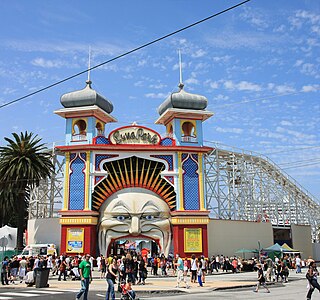
Luna Park Melbourne is a historic amusement park located on the foreshore of Port Phillip Bay in St Kilda, Melbourne, Victoria. It opened on 13 December 1912, with a formal opening a week later, and has been operating almost continuously ever since.

The Cyclone, also called the Coney Island Cyclone, is a wooden roller coaster at Luna Park in Coney Island, Brooklyn, New York City. Designed by Vernon Keenan, it opened to the public on June 26, 1927. The roller coaster is on a plot of land at the intersection of Surf Avenue and West 10th Street. The Cyclone reaches a maximum speed of 60 miles per hour (97 km/h) and has a total track length of 2,640 feet (800 m), with a maximum height of 85 feet (26 m).
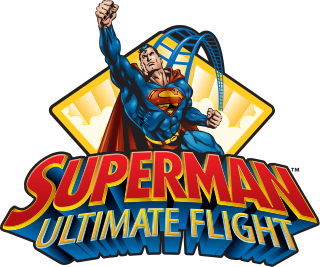
Superman: Ultimate Flight is the name of three flying roller coasters currently operating at three Six Flags amusement parks in the United States, those being Six Flags Over Georgia, Six Flags Great Adventure and Six Flags Great America. Each of these steel coasters were designed and built by Swiss manufacturer Bolliger & Mabillard and opened in 2002 and 2003. Since 2003, Six Flags has installed Superman: Ultimate Flight in three of their parks. Themed to the popular comic book character, Superman: Ultimate Flight simulates flying by positioning its passengers parallel to the track, supported by harnesses and facing the ground through most of the ride. In the station, riders board the train sitting down. After the train is locked and checked, the trains are raised into the flying position. After the ride, the seats are lowered back into the sitting position for the next round of riders.
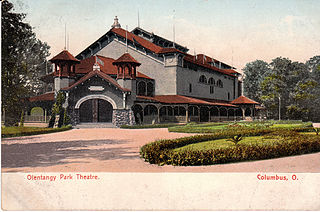
Olentangy Park was a trolley park, a type of amusement park, in Clintonville, Columbus, Ohio, operating from 1880 to 1937.
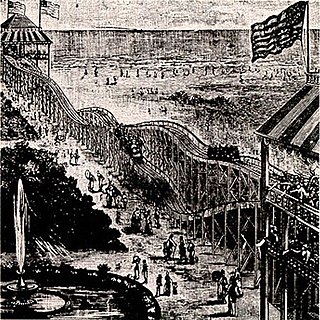
The original Switchback Railway was the first roller coaster at Coney Island in Brooklyn, New York City, and one of the earliest designed for amusement in the United States. The 1885 patent states the invention relates to the gravity double track switchback railway, which had predicated the inclined plane railway, patented in 1878 by Richard Knudsen. Coney Island's version was designed by LaMarcus Adna Thompson in 1881 and constructed in 1884. It appears Thompson based his design, at least in part, on the Mauch Chunk Switchback Railway which was a coal-mining train that had started carrying passengers as a thrill ride in 1827.

Firehawk was a flying roller coaster located at Kings Island in Mason, Ohio. Manufactured by Vekoma, it originally opened as X-Flight at Six Flags Worlds of Adventure on May 26, 2001, billed as the Midwest's first and only flying roller coaster. Cedar Fair purchased Worlds of Adventure in 2004 and began efforts to downsize the park. X-Flight was relocated to Kings Island following the 2006 season, where it reopened as Firehawk on May 26, 2007.

Sea Lion Park was a 16-acre (65,000 m2) amusement park started in 1895 on Coney Island by Paul Boyton. He fenced the property and charged admission, the park becoming the first enclosed and permanent amusement park in North America. Up until the establishment of this park, amusement areas around the country consisted of pay-as-you-go concessions. In 1903, Sea Lion Park was replaced by Luna Park.
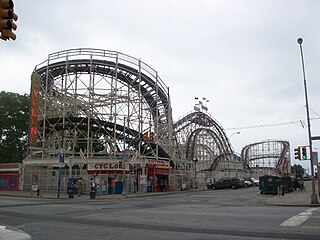
Roller coaster amusement rides have origins back to ice slides constructed in 18th-century Russia. Early technology featured sleds or wheeled carts that were sent down hills of snow reinforced by wooden supports. The technology evolved in the 19th century to feature railroad track using wheeled cars that were securely locked to the track. Newer innovations emerged in the early 20th century with side friction and underfriction technologies to allow for greater speeds and sharper turns. By the mid-to-late 20th century, these elements intensified with the introduction of steel roller coaster designs and the ability to invert riders.

Centrifugal Railway was the name of a number of early looping roller coasters that were built in Western Europe in the middle of the 19th century. These rides were very similar in their basic design to many modern day shuttle roller coasters, but with only one lift hill and no launch. A single roller coaster car would ascend to the peak on the coaster before descending rapidly down the same hill and then passing through the central loop with enough speed and centrifugal force to remain on the track at the top of the loop. The size of these centrifugal railways differed; some were purported to have vertical loops of a mere 6.5 feet (2.0 m), while others were estimated to be 40 feet (12 m).
Frederick A. Church (1878–1936) was an American engineer and early roller coaster designer. He is most famous for his "Bobs" series of roller coasters that featured severe banking, steep drops, and nonstop action.

Backety-Back Scenic Railway was a wooden roller coaster located at Crystal Beach Park. The ride opened to the public in 1909 and operated until 1926. The Backety-Back Scenic Railway was notable for a backward-traveling innovation which would be adopted many years later in more modern steel roller coasters. It was also one of the earliest shuttle roller coasters to be built, as well as being the second roller coaster to be built in the Crystal Beach amusement park. The coaster has been cited as a particularly beautiful example of roller coaster architecture.

Flip Flap Railway was the name of a looping wooden roller coaster which operated for a number of years at Paul Boyton's Sea Lion Park on Coney Island in Brooklyn, New York. The coaster, which opened in 1895, was one of the first looping roller coasters to operate in North America. It was also notable for its engineering as well as the extreme G-forces that this engineering inflicted on riders.
Lina Beecher was an American inventor and roller coaster engineer. Beecher is best known for building the first looping roller coaster in North America, which was known as the Flip Flap Railway, and a later looping roller coaster known as Loop the Loop. He is also known for designing a number of other inventions and patents with a variety of applications.
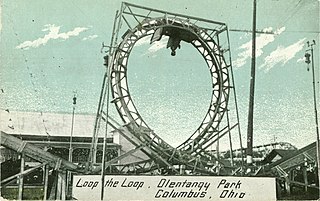
Loop the Loop was an early looping steel roller coaster which operated at Olentangy Park in Columbus, Ohio during the first decade of the 1900s. It was one of the first looping roller coasters to operate in North America, and it was designed and built by noted inventor Lina Beecher.

Loop the Loop was a steel, dual-tracked roller coaster located in Atlantic City, New Jersey. The roller coaster opened in 1901 and operated until 1912. It was one of the earliest looping roller coasters in the United States.

Cannon Coaster, sometimes known as Leap-the-Gap, was a wooden roller coaster which operated on Bowery Street in Coney Island, Brooklyn, New York, in the first decade of the 20th century.





















